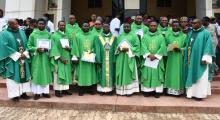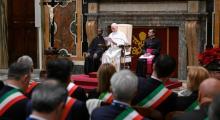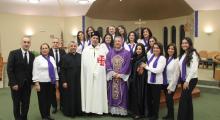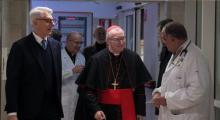Issued by the Catholic Center for Studies and Media - Jordan. Editor-in-chief Fr. Rif'at Bader - موقع أبونا abouna.org
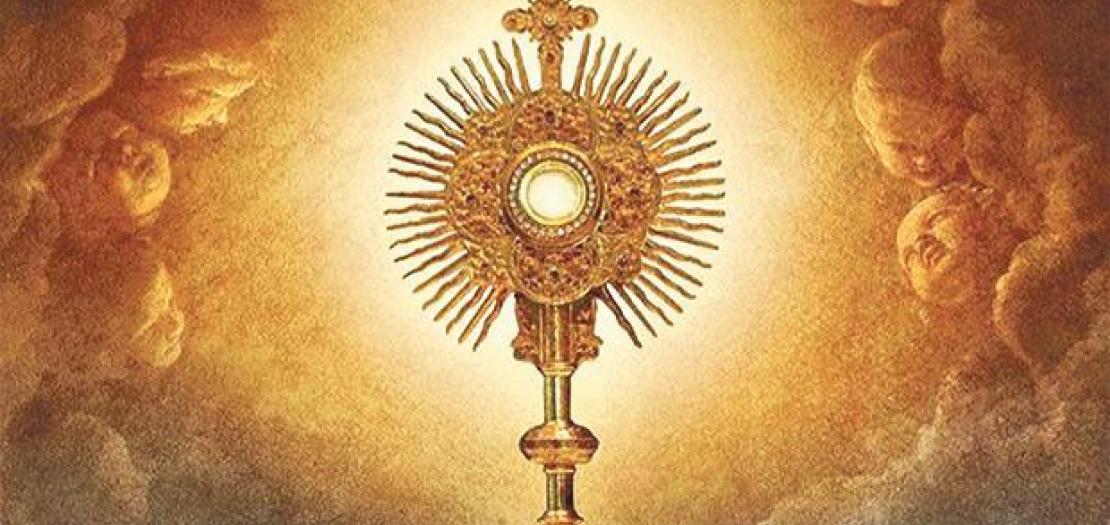
The Feast of Corpus Christi began appearing in Church calendars in the 13th century. But why then? Who promoted it? How did it become universal?
From her very beginning the Church faithfully proclaimed and actualized the teaching of Jesus: “My flesh is food indeed and my blood is drink indeed” (John 6:55). But as she emerged from the Dark Ages, new questions arose about the nature of that presence. During the eleventh and twelfth centuries, theologians applied the dialectical methods of rediscovered Greek philosophy as well as Patristic exegesis. They strove to defend the reality of the Holy Eucharist as Christ’s Body and Blood. Dissenters were censured.
The issue was settled by the ecumenical Council Lateran IV, which decreed that the entire substance of the bread and wine is transformed into the true Body and Blood of Christ without altering their appearances. The term transubstantiation used to describe—but not explain—this process had been in use since the eleventh century. It is not dependent upon the Aristotelean metaphysics of medieval scholasticism.
Lateran IV also required all Catholics above the age of reason to confess and receive Holy Communion at least once a year. Although the laity communicated rarely and had been denied access to the Precious Blood since the twelfth century, they treated the recently introduced practice of elevating the consecrated Host as the high point of attending Mass. Bells announced the moment to those inside and outside the church.
The purity of the bread and wine to be offered and the safety of the consecrated Species became matters of concern. In those days, the Blessed Sacrament was often reserved in a cupboard (aumbry) or in a locked container (pyx) hung over the altar. Freestanding towers (sacrament houses) started to appear, forerunners of the later altar tabernacles. Sanctuary lamps burned beside the reserved Eucharist in honor of Christ’s Presence.
This flowering of Eucharistic theology and worship was accompanied by vigorous preaching. Typically, the faithful were catechized with miracle stories and exempla that emphasized the living reality of Jesus. Lay piety burgeoned in response. No longer was holiness the special province of clergy and religious. The Eucharist-centered mysticism of medieval holy women became a distinctive feature of spirituality in the Middle Ages. Three-quarters of medieval lay saints were be female and the overwhelming majority of miracles involving the Eucharist happened to women.
Into this world Juliana of Mt. Cornillon was born in 1190 near Liége, a city with a long tradition of scholarship and eucharistic fervor. Orphaned at an early age, Juliana was raised by the Canonesses of St. Augustine and joined their community. It was a double monastery which some sources confusingly call Norbertine. Around 1208, Juliana began to have repeated visions of a bright moon “with a little break in part of its sphere.” She pondered for twenty years until Jesus appeared to her and explained that the dark blemish was a feast missing from the Church calendar: a celebration of the Holy Eucharist.
Juliana kept quiet about her revelation until 1225 when she was elected prioress. Then she shared her idea with her confessor, a priest at St. Martin’s Church where her friend Eva lived as an anchoress. He consulted the bishop, Archdeacon Jacques Pantaleon, and learned Dominicans who passed the suggestion on to the chancellor of the University of Paris. No one objected so the bishop of Liége proclaimed a Feast of Corpus Christi for his diocese in 1246. Unfortunately, he died a few months later at the Cistercian monastery of Fosses.
The new bishop was unsympathetic and cancelled the feast. The prior of Mt. Cornillon, superior over both sections of the monastery, was even more hostile. He accused Juliana of embezzling funds from the leper hospital which she administered and roused the citizens of Liége against her. Removed from office in 1247, she left the city and spent the rest of her life in exile. For a while she joined a community of laywomen (beguines) and then lived in a Cistercian monastery near Namur, but it was burned down in a war. Juliana ended her days as a recluse at Fosses in 1258, the same house where her friendly bishop had died twelve years earlier.
Meanwhile, Hugo of St. Cher, a notable Dominican who was Cardinal-Legate of Germany, visited Liége in 1251. He had the Feast of Corpus Christi celebrated at St. Martin’s Church, promoted it enthusiastically, and instituted it throughout German territories the following year. Hugo’s successor was equally supportive and continued his advocacy.
Archdeacon Jacques Pantaleon, who had attended the very first celebration of Corpus Christi, went on to become bishop of Verdun, patriarch of Jerusalem, and finally pope, taking the name Urban IV. In 1264, he issued Transiturus, the first papal proclamation of a new universal feast but died before the document had time to leave the curia. Urban did, however, send a personal letter to Juliana’s old friend Eva of St. Martin who had never ceased promoting Corpus Christi. She died the following year.
Although the next 13 popes ignored Transiturus, the celebrations of Corpus Christi continued to spread across Europe through the initiatives of individual parishes (including St. Martin’s in Liége), German dioceses, Cistercian monasteries, the Dominican Order, and the city of Venice. The feast day was proclaimed once again in the papal letter Si dominum incorporated into a new collection of canon law called the Clementines. But Clement V, the Avignonese pope who had suppressed the Order of Knights Templar, died in 1314 before the official approval of the collection was complete. His successor, John XXII, revised and published the Clementines in 1317. After so many disappointments and delays, the Feast of Corpus Christi was finally installed in the universal calendar of the Church. The blotch on the moon’s bright face had been wiped away at last, more than a century after Juliana first saw it. In honor of their efforts to promote Corpus Christi, the first major Church festival suggested by a woman, Blessed Juliana of Mt. Cornillon and St. Eva of St. Martin have now have their own places in the rolls of sainthood.
Papal proclamation would have counted for little without the fervent response of the faithful, eager to adore Our Lord’s eucharistic presence. The festive Mass and the solemn procession that followed were well suited to express medieval culture’s drive to make the supernatural seem concrete. Each local procession linked the town to the cosmos. Bearing public witness to the sacramental reality of Christ’s Body and Blood rebuked heretics, from the anti-material Cathars to the Lollards and Hussites who denied transubstantiation. Feast day rituals and sermons were designed to strengthen faith and dispel doubt, with the added benefit of indulgences. Confraternities and guilds of the Blessed Sacrament added extra color to the festivities while benefitting their members in body and soul.
The feast of Corpus Christi unleashed creativity as well as devotion across Christendom. Thomas Aquinas wrote magnificent hymns for the occasion that turn doctrine into poetry: the sequence Lauda Sion, Pange lingua (source of Tantum ergo), Sacra solemniis juncta sint gaudia (source of Panis angelicus), Verba supernum prodiens (source of O salutaris hostia), and Adoro te devote. Besides formal liturgies, the Hours of the Sacrament were added to laypeople’s personal prayer books.
Corpus Christi inspired new religious art for church decoration and illuminated books. The monstrance, already used to display relics, gradually evolved into its familiar form to showcase the Blessed Sacrament for processions, adoration, and benediction. The feast was also honored with public tableaux and dramas. In medieval England, cycles of mystery plays staged around the time of the feast drew huge crowds to York, Chester, Coventry, and other towns. European cities also had similar performances as well as miracle plays centered on stories about the Eucharist itself.
Celebrating the Solemnity of the Most Holy Body and Blood of Christ unites the sublime to the simple even as the Incarnation joins Divinity to humanity. The Corpus Christi procession symbolizes our journey to Our Savior’s everlasting banquet where we will see him as he is.


